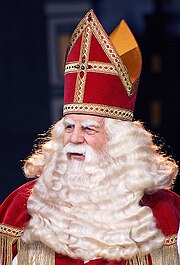2009-12-05 - Pakjesavond (The Netherlands)
In the Netherlands, Saint Nicholas' Eve (December 5) is the chief occasion for gift-giving and the evening is called "sinterklaasavond" or "pakjesavond" ("presents evening"). The name Santa Claus supposedly derived from older Dutch Sinte Klaas.
Source: The FullCircles Multicultural Calendar
================================
Sinterklaas (also called Sint-Nicolaas or De Goedheiligman in Dutch and Saint Nicolas in French) is a traditional Winter holiday figure in the Netherlands, Aruba, Suriname, Netherlands Antilles and Belgium, celebrated every year on Saint Nicholas' eve (December 5) or, in Belgium, on the morning of December 5. The feast celebrates the name day of Saint Nicholas, patron saint of, among other things, children.
It is also celebrated in parts of France (North, Alsace, Lorraine), as well as in Luxembourg, Switzerland, Germany, Austria, Poland, Hungary, Croatia, Romania, Slovakia, Slovenia, the Czech Republic and in the town of Trieste and in Eastern Friuli in Italy. Additionally, many Roman Catholics of Alsatian and Lotharingian descent in Cincinnati, Ohio, celebrate "Saint Nicholas Day" on the morning of December 6. The traditions differ from country to country, even between Belgium and the Netherlands.
In the Netherlands, Saint Nicholas' Eve (December 5) is the chief occasion for gift-giving. The evening is called "sinterklaasavond" or "pakjesavond" ("presents evening"). In the Netherlands, children receive their presents on this evening whereas in Belgium, children put their shoe in front of the fireplace on the evening of December 5, then go to bed, and find the presents around the shoes on the morning of the 6th.
Sinterklaas is the basis for the North American figure of Santa Claus. It is often claimed that during the American War of Independence the inhabitants of New York City, a former Dutch colonial town (New Amsterdam) which had been swapped by the Dutch for Suriname, reinvented their Sinterklaas tradition, as Saint Nicholas was a symbol of the city's non-English past.[1] The name Santa Claus supposedly derived from older Dutch Sinte Klaas. However, the Saint Nicholas Society was not founded until 1835, almost half a century after the end of the American War of Independence.[2] A study of the "children's books, periodicals and journals" of New Amsterdam by Charles Jones revealed no references to Saint Nicholas or Sinterklaas.[3] However, not all scholars agree with Jones's findings, which he reiterated in a booklength study in 1978;[4] Howard G. Hageman, of New Brunswick Theological Seminary, maintains that the tradition of celebrating Sinterklaas in New York existed in the early settlement of the Hudson Valley, although he agrees that "there can be no question that by the time the revival of St. Nicholas came with Washington Irving, the traditional New Netherlands observance had completely disappeared."[5] The Saint Nicholas Society of New York still has a feast on December 6 to this day.
In the Netherlands, Saint Nicholas' Eve (December 5) is the chief occasion for gift-giving and the evening is called "sinterklaasavond" or "pakjesavond" ("presents evening"). The name Santa Claus supposedly derived from older Dutch Sinte Klaas.
Source: The FullCircles Multicultural Calendar
================================

Sinterklaas (also called Sint-Nicolaas or De Goedheiligman in Dutch and Saint Nicolas in French) is a traditional Winter holiday figure in the Netherlands, Aruba, Suriname, Netherlands Antilles and Belgium, celebrated every year on Saint Nicholas' eve (December 5) or, in Belgium, on the morning of December 5. The feast celebrates the name day of Saint Nicholas, patron saint of, among other things, children.
It is also celebrated in parts of France (North, Alsace, Lorraine), as well as in Luxembourg, Switzerland, Germany, Austria, Poland, Hungary, Croatia, Romania, Slovakia, Slovenia, the Czech Republic and in the town of Trieste and in Eastern Friuli in Italy. Additionally, many Roman Catholics of Alsatian and Lotharingian descent in Cincinnati, Ohio, celebrate "Saint Nicholas Day" on the morning of December 6. The traditions differ from country to country, even between Belgium and the Netherlands.
In the Netherlands, Saint Nicholas' Eve (December 5) is the chief occasion for gift-giving. The evening is called "sinterklaasavond" or "pakjesavond" ("presents evening"). In the Netherlands, children receive their presents on this evening whereas in Belgium, children put their shoe in front of the fireplace on the evening of December 5, then go to bed, and find the presents around the shoes on the morning of the 6th.
Sinterklaas is the basis for the North American figure of Santa Claus. It is often claimed that during the American War of Independence the inhabitants of New York City, a former Dutch colonial town (New Amsterdam) which had been swapped by the Dutch for Suriname, reinvented their Sinterklaas tradition, as Saint Nicholas was a symbol of the city's non-English past.[1] The name Santa Claus supposedly derived from older Dutch Sinte Klaas. However, the Saint Nicholas Society was not founded until 1835, almost half a century after the end of the American War of Independence.[2] A study of the "children's books, periodicals and journals" of New Amsterdam by Charles Jones revealed no references to Saint Nicholas or Sinterklaas.[3] However, not all scholars agree with Jones's findings, which he reiterated in a booklength study in 1978;[4] Howard G. Hageman, of New Brunswick Theological Seminary, maintains that the tradition of celebrating Sinterklaas in New York existed in the early settlement of the Hudson Valley, although he agrees that "there can be no question that by the time the revival of St. Nicholas came with Washington Irving, the traditional New Netherlands observance had completely disappeared."[5] The Saint Nicholas Society of New York still has a feast on December 6 to this day.
Comment
© 2025 Created by Steve Hargadon.
Powered by
![]()
You need to be a member of Classroom 2.0 to add comments!
Join Classroom 2.0